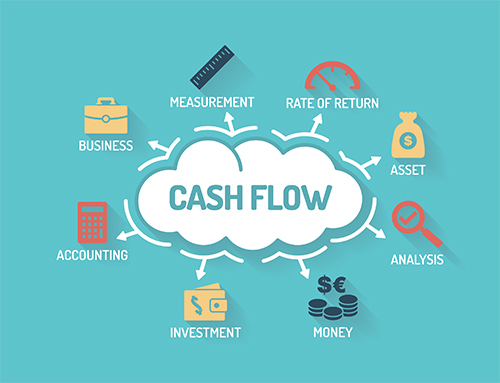The current situation in South Africa has many business owners worried about their cash flow situation. Getting through the next few weeks or even months is crucial to maintain a stable financial situation in South Africa. Cash is King, and this has never been truer in the financial management of businesses than now. Profitability does not equal good cash flow and 60% of businesses fail because they run out of cash, not because they are not profitable.
A shortage of cash flow can prevent you from paying suppliers, buying materials and even paying salaries. The time delay between the time you have to pay your suppliers and the time you receive money from your customers is the problem, and the solution is cash flow management which means to delay outlays of cash for as long as possible and receiving cash from customers as soon as possible.
It is important to understand the basics of cash flow management before we can look at some strategies to improve and manage cash flow in your business.
What is Cash Flow?
According to Investopedia, cash flow is “the net amount of cash and cash-equivalents being transferred into and out of a business. At the most fundamental level, a company’s ability to create value for shareholders is determined by its ability to generate positive cash flows, or more specifically, maximize long-term free cash flow.”
- Positive Cash Flow:
Investopedia defines positive cash flow as “(it) indicates that a company is adding to its cash reserves, allowing it to reinvest in the company, pay out money to shareholders, or settle future debt payments.”
- Negative Cash Flow:
Negative cash flow is described by Business Dictionary as “(the) situation where the cash outflows during a period are higher than the cash inflows during the same period. Negative cash flow does not necessarily mean loss and may be due only to a mismatch of expenditure and income.”
Being profitable doesn’t mean positive cash flow
Various factors influence your cash flow and a profit and loss statement will not give you an indication of your cash flow. Consider accounts receivable, inventory, accounts payable, capital expenditures and taxation as part of your cash flow projections. Earning a profit is not the same as knowing how you’ve spent your cash.
It is important to know what amount of working capital needed to operate your business. Answer questions like:
- How much inventory do I need to hold?
- How many invoices are overdue?
- How much cash is tied up in work in progress?
- How long does it take from paying our suppliers for the materials to extracting cash from the customers?
We can help you anticipate inflows and outflows of money over a period or you can even use spreadsheets to assist you with that. Understand that cash flow plans are not glimpses into the future. They’re educated guesses that balance several factors, including your customers’ payment histories, your own thoroughness at identifying upcoming expenditures, and your vendors’ patience.
How do I do a cash flow projection?
- Step 1
- What cash does your business have on hand for the start of the period?
- Step 2
- Estimate incoming cash for the following period.
- Step 3
- Estimate expenses for the following period.
- Step 4
- Substract estimated expenses from income.
- Step 5
- Add cash flow to opening balance.
Solutions to improve your cash flow situation
Theoretically, it seems quite simple to improve your cash flow situation – improve the speed with which you turn materials and supplies into products, inventory into receivables, and receivables into cash.
Let’s look at some practical options for improving cash flow:
- Offer discounts to customers who are quick payers.
- Let customers pay deposits before starting work or placing orders.
- Require credit checks on all new non-cash customers.
- Liquidate cash tied up with assets.
- Don’t wait until month end to send out invoices. Rather issue it immediately after work is done or orders are delivered and follow up immediately if payment is not received in reasonable time. Make your invoices as clear and as detailed as possible.
- Make it as easy as possible for your customers to pay you.
- Track accounts receivable to identify and avoid slow-paying customers. Instituting a policy of cash on delivery (c.o.d.) is an alternative to refusing to do business with slow-paying customers.
- Take full advantage of creditor payment terms. If a payment is due in 30 days, don’t pay it in 15 days.
- Communicate with your suppliers so they know your financial situation. If you ever need to delay a payment, you’ll need their trust and understanding.
- Don’t always focus on the lowest price when choosing suppliers. Sometimes more flexible payment terms can improve your cash flow more than a bargain-basement price.
- Short-term financing such as a line of credit can be used to make emergency purchases or to bridge the gap between payables and receivables. Many banks issue business credit cards that you can use to pay your vendors
- Large asset purchases such as equipment and real estate should usually be financed with long-term loans rather than with your working capital. This allows you to spread the payments over the average life of the assets. You’ll be paying interest, but you’ll have preserved your working capital for business operations.
If your cash flow stays positive, your business can survive turbulent waters. Project future cash flows based on history and sound financial data, always keep your income balances and sheets up to date and stay vigilant.

